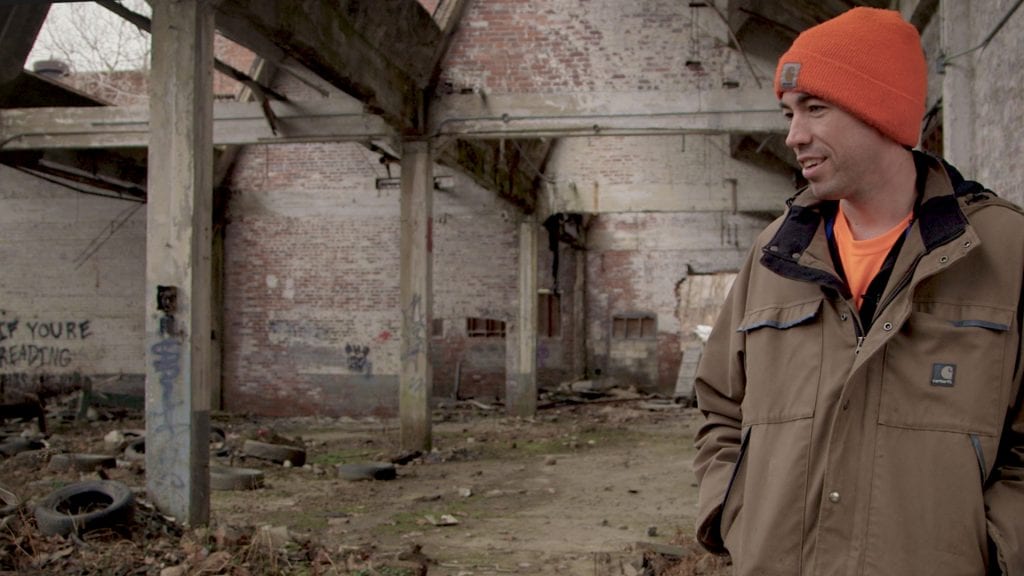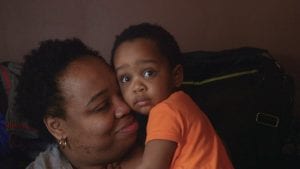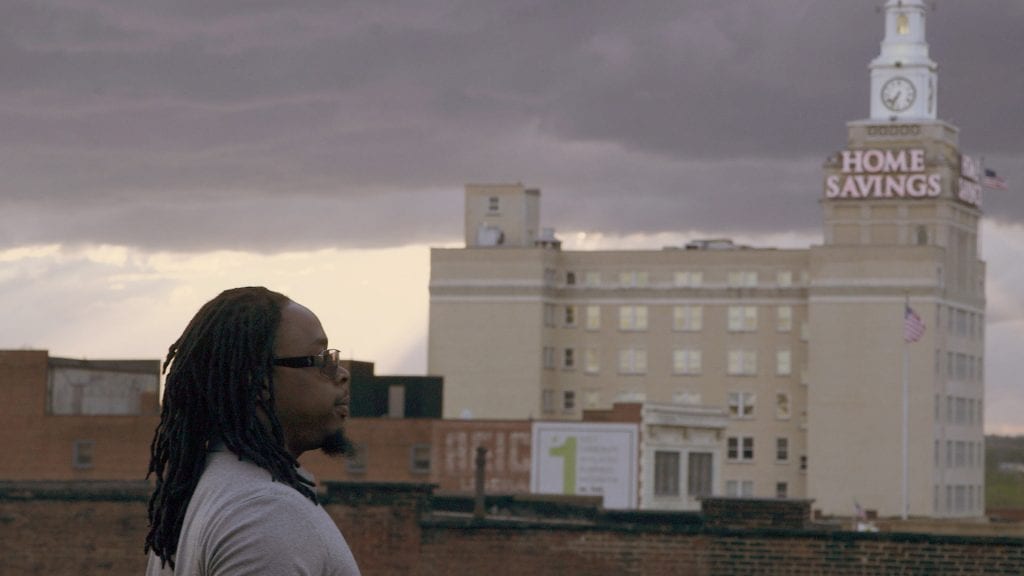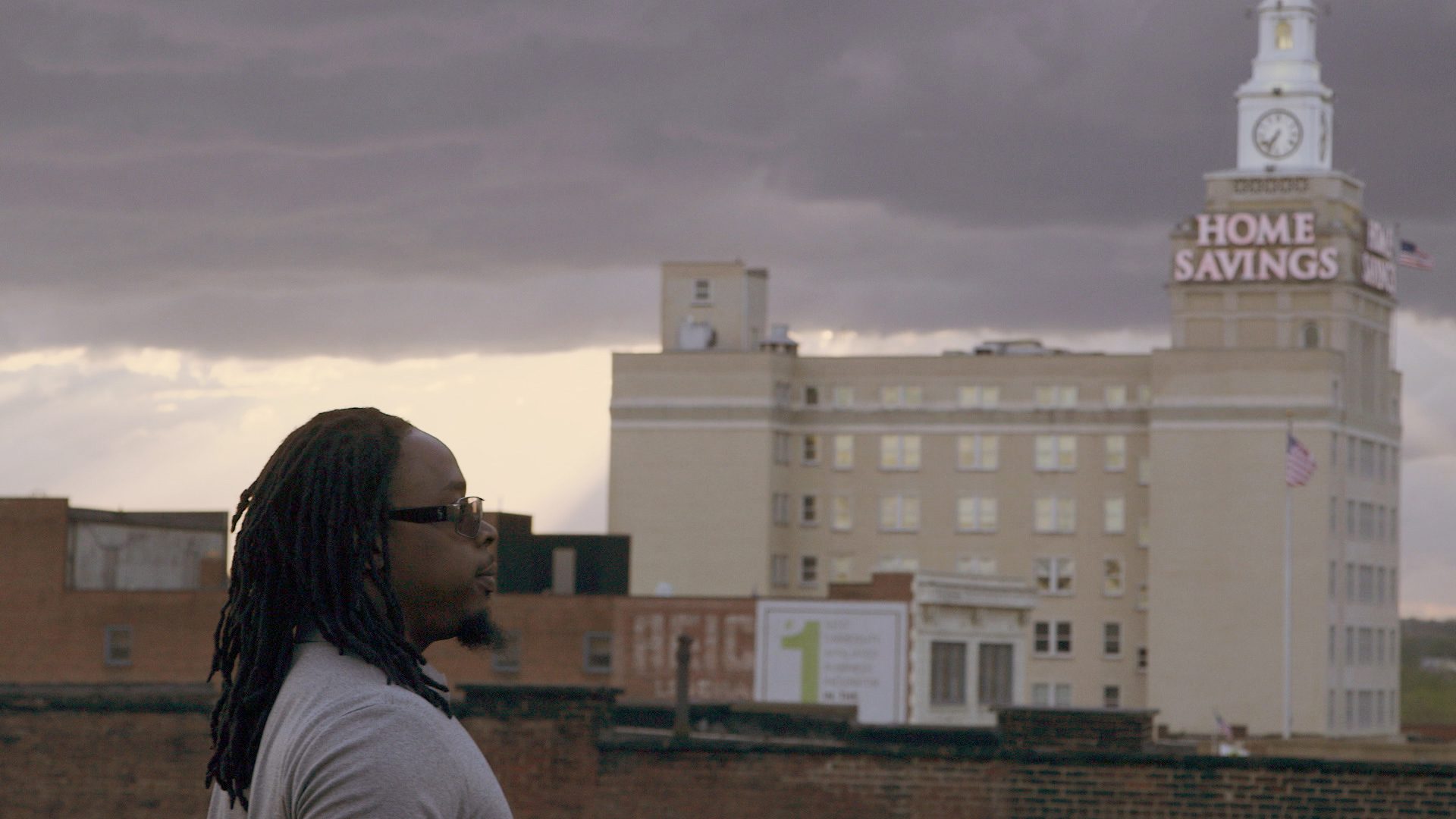
Still photo of Ian Beniston from “The Place that Makes Us” courtesy of the filmmakers
The Place That Makes Us is a look at Youngstown, Ohio, through the eyes of a number of young people who have bucked the trend of “getting out” and decided to stay in their hometown and fight for it. It gives a snapshot into the personal and work lives—and the often-blurry lines between them—of a couple of staff members at the Youngstown Neighborhood Development Corporation, a business owner who also became a city council member, and a city staffer who works on codes and demolition.
Youngstown is, possibly even more than Detroit, a place that is familiar to much of the country only for its struggles, ever since the mass steel mill closures began there in the 1970s. The Place That Makes Us walks an interesting line regarding this. It intentionally avoids the kind of “ruin porn” that dramatizes decay and often leaves residents of the place depicted angry at how they’ve been stigmatized and pigeonholed. But the film also doesn’t ignore the past and its effects on the present. Indeed, the archival footage from Youngstown at its heyday interwoven with interviews that encompass residents who remember it and those who don’t, but whose childhoods were deeply affected by the ripple effects, leaves the viewer with a powerful sense of just how long the effects of such a shock linger in a place.

Photo of a new homeowner feature in the film, courtesy of the filmmakers
The Place That Makes Us has won numerous awards at various film festivals and is frequently described as poetic. That’s a good description. People are introduced by their first names only. No title or organization or relation to others in the film is given; we figure out such things, if we do at all, when people decide to tell us themselves. Homes, family stories, and workplaces feature as prominently as the community sites that are being addressed.
The Place That Makes Us is also at least as notable for what it leaves out as what it includes. The list of things one might expect (for good or ill) to find in a documentary about revitalization work in Youngstown, Ohio, but that do not appear is long. Here are the ones that struck me the most.
Statistics, either grim or encouraging—We get a few numbers about the loss of jobs and an occasional news clip mentioning crime, but there is no litany of poverty rates, average income, property values, or even vacancy rates. The effects of the loss of the steel mills are portrayed entirely in a qualitative fashion: a woman recounting which houses on her block are empty; City council member Julius Oliver visiting the sites of his childhood homes, both of which have been demolished. Sometimes this is a relief. We hear such numbers recounted frequently enough to become numb to them. And no statistic is likely to better communicate the horror of watching your hometown fall apart around you and feeling trapped in it than the quiet but blunt anguish in the conversations with the parents of Ian Beniston, director of Youngstown Neighborhood Development Corporation (YNDC), who are still hoping he can get out despite his commitment to staying. But sometimes the absence of any data is frustrating—toward the end there’s reference made to the work of the YNDC contributing to a decrease in vacancy rates, but no one ever tells us anything about the size of that decrease, leaving it feeling amorphous.
Boosterism—the flip side of the over-grim portrayals of places that have undergone the kinds of things Youngstown has is the Chamber of Commerce–style hype that tries to convince potential investors that a town is on the rise again, selectively emphasizing new employers, new downtown businesses, and a city’s extreme eagerness to welcome more of each. Despite the fact that it is clear that the film’s subjects are devoted to their hometown (in little touches like the map of Ohio with a heart in Youngstown’s location on someone’s desk or nightstand), there is really no boosterism here, which is refreshing, if sometimes perhaps a little extreme. You could end the film without knowing that a new steel mill did open in the city in 2011, that there is a countywide land bank, or that Youngstown State University is present and active in the city.
Details about how YNDC does its work—The story of this film is people driven, and even if those people are engaged in some very strategic revitalization work, which they are, it is their stories, their relationships to their work, their decision to stay and their lives in Youngstown today that take center stage, along with the arc of one particular house moving from abandonment to new homeowner. This means that we don’t get a very clear picture of the truly impressive scope of work of the organization at the heart of the film. Despite a brief mention of a block-focused strategy, viewers could come away thinking YNDC only rehabs vacant houses, and does so wherever it finds them, when in fact YNDC has an extremely comprehensive, targeted, and data-driven approach. Where YNDC’s funding comes from, how the city and YNDC decide which houses to demolish and which to try to save, the process of choosing which neighborhoods to focus on, how YNDC thinks about affordability in the context of revitalization, and similar questions that anyone who does this work is going to wonder about remain not only unanswered, but barely alluded to. Leaving the impression that YNDC’s work is more simplistic and less strategic than it is does the organization a disservice.
[Related Story: How Does YNDC Fight Vacancy? It Does a Little of Everything.]
Larger context—Similarly, viewers of the film don’t hear any mention of Youngstown 2010, the ground-breaking planning process in which the participants decided the city should move away from yearning after its large-scale past and decide to focus on being the best small city it can be. At the time it seemed like an important turning point psychologically for many in the city, but it raised a host of questions about how you resize a city properly without causing more trauma and loss. Whether they refer to that plan or not, those kinds of trade-offs are absolutely part of the work that YNDC does, but the film portrays their work as much more scattershot—reclaiming one house at time from the wilds of abandonment.
Race—It seems from the film that YNDC’s staff is all white, while the leaders who gather on the basketball court of the massive fieldhouse they are hoping to turn into a community center are all Black (though YNDC supports the project). We can see this, but we don’t get any context for it. Is the city segregated? (Most likely.) Who makes decisions for whom? It’s clearly not a post-racial utopia. Youngstown is 49 percent white, 42 percent Black—but opportunity for Black and white children of Youngstown is wildly disparate (a ranking of 3 out of 100, on one scale, for Black children, compared to 50 out of 100 for white children). The causes and effects of this are likely place-based, relevant to, and hopefully taken into account in the decision-making processes of the people we see in the film, but we don’t hear anyone grapple with that, or even acknowledge it. Seeing one white YNDC staffer taking a personal caring-adult role for some Black kids she met at a volunteer day is feel-good (if also a bit white-savior-ish), but it doesn’t replace addressing the power dynamics of race and place directly.

Councilmember Julius T. Oliver. Photo courtesy of the filmmakers
In the end, The Place That Makes Us is more an exploration of the personal experience of sticking with a place that has been abandoned by others than a blueprint for solutions. There can be a place for that. Watching an exuberant volunteer day where dozens of people muck out a long-abandoned home, and then later seeing a new homeowner move in are certainly joyful moments. If the goal is to convey a sense of not only the humanity, but the persistence of Youngstown, the film succeeds. It might be a good candidate for community developers working in similar places to share with relatives who want to know why they are still working/living where they are and what they get out of what they are doing. Those who want to really understand the scope of what the various city stakeholders are doing to work toward healthier Youngstown neighborhoods and how they are doing it will have to do more looking.
The Place That Makes Us will have its broadcast premier on America Reframed on March 30, at 8 p.m. Eastern time. Find your local station here.
Watch clips from a Q&A with filmmakers and participants at the Big Sky Documentary Festival.






Comments